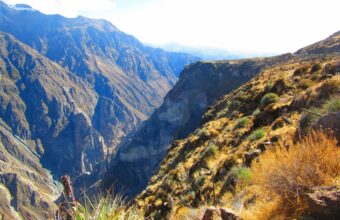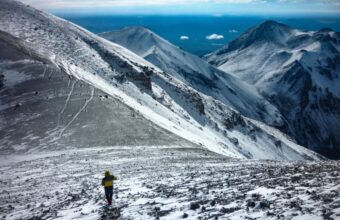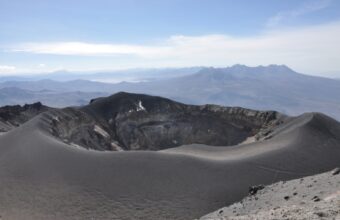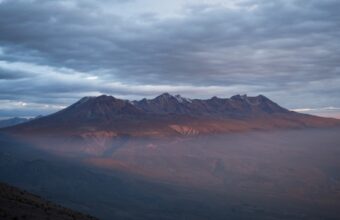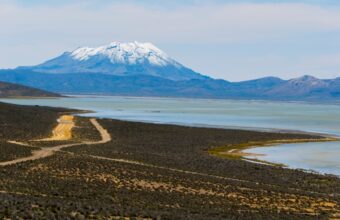Arequipa treks
Trekking the volcanoes and canyons of Southern Peru
Last updated 23 Apr 2024
The Arequipa region in southern Peru is famous for its volcanoes and the harsh beauty of its desert landscapes.
This is one of the best places in the world to hike up a volcano because the trails, although tough, are not technical climbs. It’s also great for spotting condors and vicuñas, the wild cousin of the llama.
Be prepared for high altitude - most treks around Arequipa take you to almost 6,000 metres above sea level. April to October is the best hiking season, when there is almost no precipitation and little risk of any snow or ice on the trails.
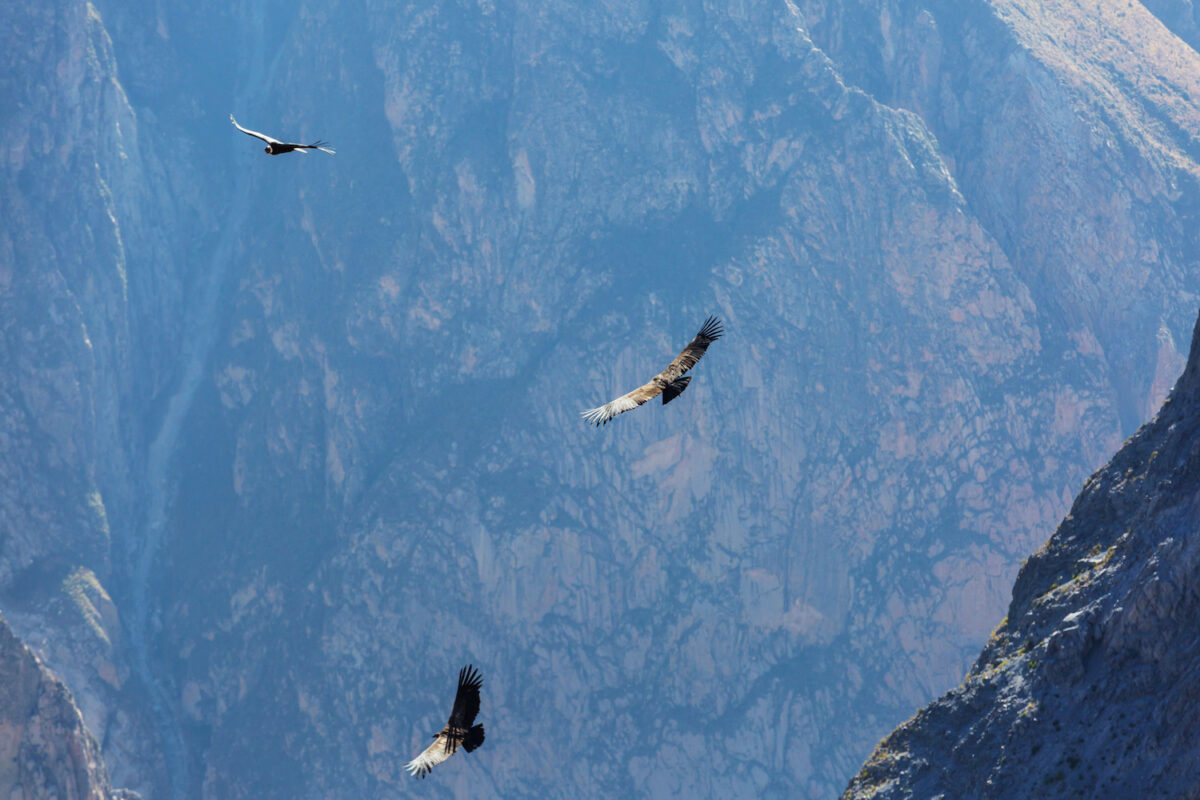
Condors soaring over the Colca Canyon
Best Arequipa treks
Popular hikes and hidden gems
Treks in the Arequipa region are best done with a licensed local agency and guide. Trails are not well marked and the high-altitude terrain is beautiful but also unforgiving.
-
Colca Canyon
-
Arequipa
-
Arequipa
-
Arequipa
-
Arequipa

Colca Canyon
Colca Canyon trek
- Difficulty: Moderate to strenuous
- Distance: 14km
- Duration: Two days
- Max elevation: 3,500 metres
- Start/end point: Cabanaconde
The Colca Canyon Trek is by far the most popular trek in the Arequipa region. The trailhead is in Cabanaconde, 220km (4/5 hour drive) from Arequipa. The route takes you into the Colca Canyon, one of the deepest canyons in the world, and offers spectacular views of the Andes Mountains and the Colca River.
The standard two day trek from Cabanaconde to San Juan de Chuccho involves around 7km hiking each day. It doesn't sound like far, but the altitude will make you feel otherwise. Some agencies offer a three day itinerary that is easier and includes a night in Sangalle. There are also day tours from Arequipa, which aren't really advisable: it's mostly driving with a short hike.
Just 20 minutes before you arrive at the trailhead, you’ll stop at the Cruz del Condor, where condors soar so close to the canyon walls that you will feel like you can reach out and touch them. After you hike down into the canyon, the trail follows the Colca River, passing through small villages and terraced fields. The hike up out of the canyon from San Juan de Chuccho back to Cabanaconde is gruelling, especially if you don’t start early enough and you are subject to the harsh desert sun.
I'd strongly advise you don't attempt this (or any hike in the Andes) without giving yourself plenty of time to acclimatise.
Accommodation
There are both hotels and homestays in San Juan de Chuccho. If you book through an agency, they will already have a room reserved for you. If you are hiking on your own, you can find a place on arrival.
How to book
Guided treks are widely offered by agencies in Arequipa, Lima and Cusco. You can book ahead of time or upon arrival. If you are booking through an agency that’s not located in Arequipa, ask which local operator they use so you can check reviews of the guides and services.

Arequipa
Chachani Volcano trek
- Difficulty: Challenging
- Distance: 31 km
- Duration: Two days
- Max elevation: 6,035 metres
- Start/end point: Arequipa
The Chachani Volcano is the highest volcano in the Arequipa region and has four summits, the highest of which is 6,075 metres. Despite being the highest, it is not the most popular volcano so you have a good chance of having the summit to yourself. The climb is not technical, though you may need crampons and ice axes December through February.
The drive from Arequipa to the trailhead takes about three hours. The hike up to base camp at 5,170 metres takes about two hours. Most guides will get their group up at about 3:00am so you can reach the summit early in the day. Afterwards, you’ll hike down to the trailhead and drive back to Arequipa.
This is a challenging trek because of the altitude but the views are absolutely worth it. The trail towards the top has loose rocks and ash, which can make walking more difficult.
You will camp at 5,300 metres, so be sure the agency includes a four season sleeping bag or bring your own. You may also want a sleeping bag liner for extra warmth. Spend at least a couple days hiking above 4,000 metres before attempting Chachani.

Arequipa
Misti Volcano trek
- Difficulty: Moderate to strenuous
- Distance: 24km
- Duration: Two days
- Max elevation: 5,825 metres
- Start/end point: Arequipa
Misti is the most popular of Arequipa’s volcanoes partly because it’s the closest to the city. Misti is a perfectly cone-shaped volcano and the one you’ll notice first when you arrive in Arequipa. There are no trees on the mountain, so you’ll have unobstructed views of the entire region.
There are two trails, up the south and north faces of the mountain. The northern route called Aguada Blanca is the most common. The second morning starts early so you can get up to the summit in the morning and be heading back down before the sun is too strong.
As with all hikes in the Arequipa region, the most difficult part of the trek is the altitude. The trail is not technical, though towards the top some parts of the trail are covered with loose ash.
You’ll start at 4,140 metres and hike up to Monte Blanco camp at 4,760 metres. Be sure to ask the tour operator about the quality of the tents and sleeping bags. If they don’t have four season bags, bring your own.
There is another trail on the south side of the mountain called the Chiguata variant. This second route takes you up to the summit via the town of Chiguata. You’ll drive 30 km from Arequipa to the town of Chiguata at 2,970 where you’ll start hiking. You’ll spend the night at Camp Piramide at 4,700 metres before making the summit ascent the next morning.

Arequipa
Picchu Picchu trek
- Difficulty: Moderate
- Distance: 16km
- Duration: Two days
- Max elevation: 5,664 metres
- Start/end point: Arequipa
Picchu Picchu, pronounced peek-chu, is a crescent shaped crater of a much larger volcano that erupted long ago. There are seven peaks, the highest of which is 5,664 metres. Picchu Picchu was sacred for Inca and pre-Inca civilisations, which often made offerings and sacrifices on the volcano. In 1986 the mummy of a child was found here with gold and silver artefacts.
The road from Arequipa to the trailhead takes you past Laguna de las Salinas at 4,300 metres. You’ll see pink flamingos as well as llamas, alpacas and vicuñas. On the hike you’ll go by a platform that the Inca used to make sacrifices. The first day is a short walk from the trailhead. You’ll get up around 3:00 am to start hiking early and be at the summit for sunrise. The hike takes about six hours roundtrip.
This is the easiest of the Arequipa volcanoes, though not the most popular. Most agencies take trekkers up the Coronado Cumbre peak that is 5,664 metres high.
Base camp is at 4,400 metres, so be prepared for a very cold night.
On the second day, on the way back to Arequipa most agencies stop at the town of Chinguata so you can see a traditional Andean village.

Arequipa
Ubinas trek
- Difficulty: Moderate
- Distance: 5km
- Duration: Two days
- Max elevation: 5,672 metres
- Start/end point: Arequipa
The Ubinas (also sometimes spelled Uvinas) trek is located in the southern region of Peru, near the city of Arequipa. The trek takes you to the summit of Ubinas, the most active volcano in Peru. Looking down into the crater you’ll see puffs of ash and sulphur. The volcano has been active for over 800 years and has had two eruptions during that time.
On the drive out from from Arequipa you’ll probably stop at Laguna Salinas to see flamingos, llamas, alpacas and vicuñas. You’ll continue the drive to Piscococha, a Quechua name which translates to Bird Lake. This is one of the shortest volcano treks near Arequipa but agencies still run it as a two day itinerary so that you can start walking early without a long drive on the same morning.
This is the best volcano near Arequipa for people who are unsure about hiking at altitude but who want to see an active volcano.
About the author
Heather Jasper
Based in Cusco, Peru, Heather is an expert on travel to Peru and South America. Heather writes on tourism, trekking, and social issues in Peru for publications including BBC Travel, Fodor’s Travel, Matador Network, Thrifty Nomads, World Nomads, Frommer's, Flashpack, and more. Heather co-founded the Covid Relief Project with Henry Quintano Loaiza to assist vulnerable families in the Cusco region.
I'm here to answer any of your questions

